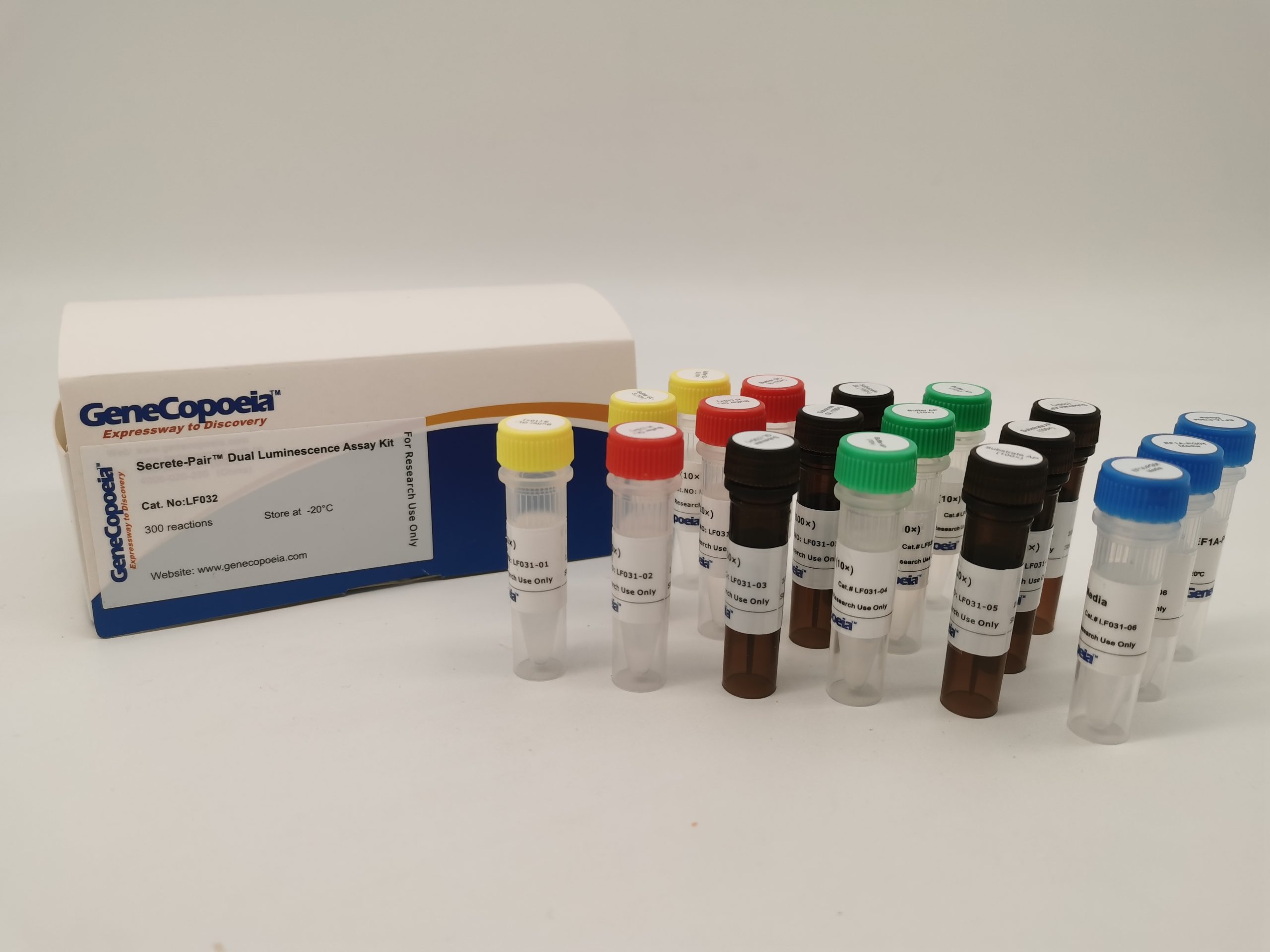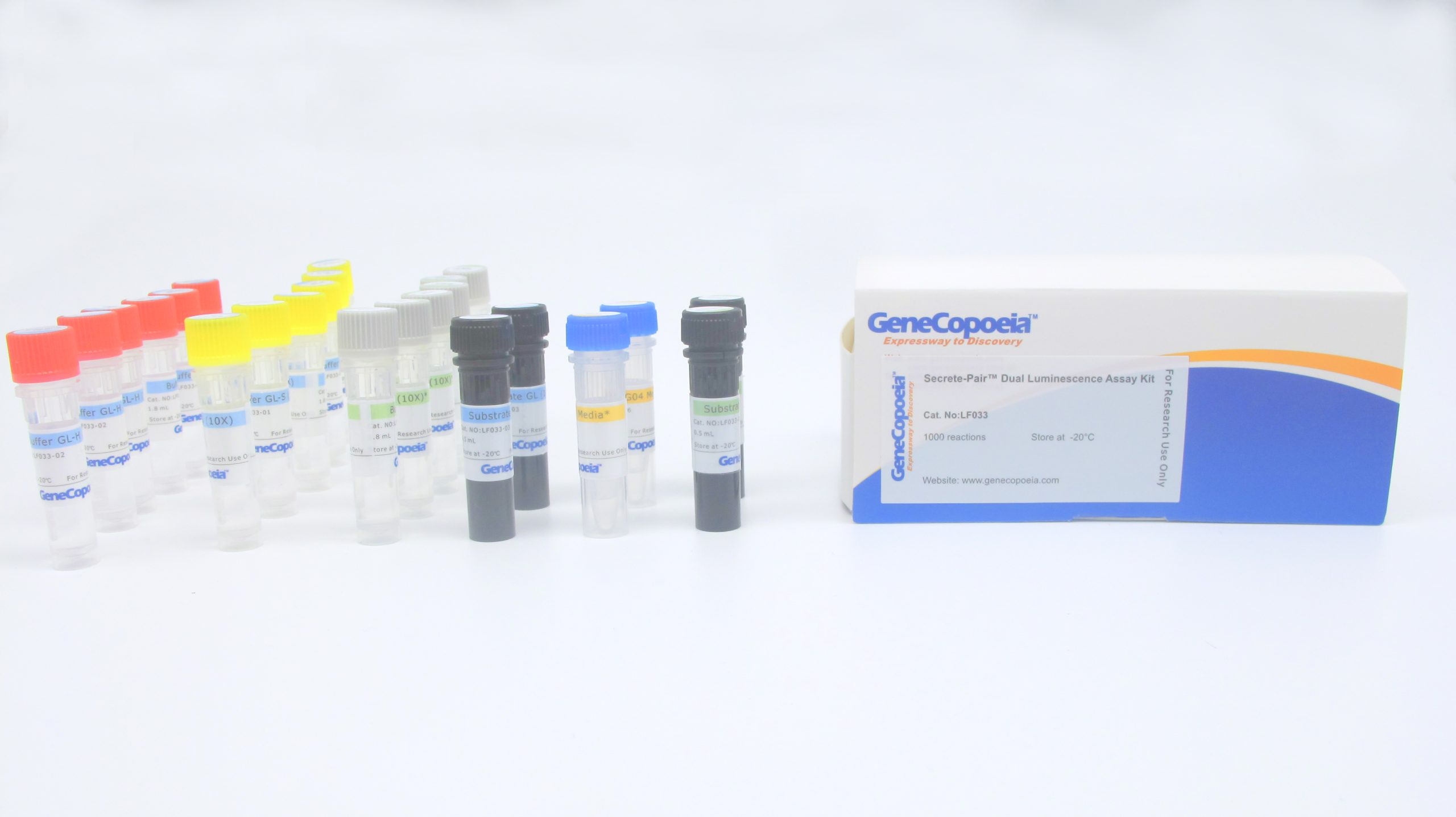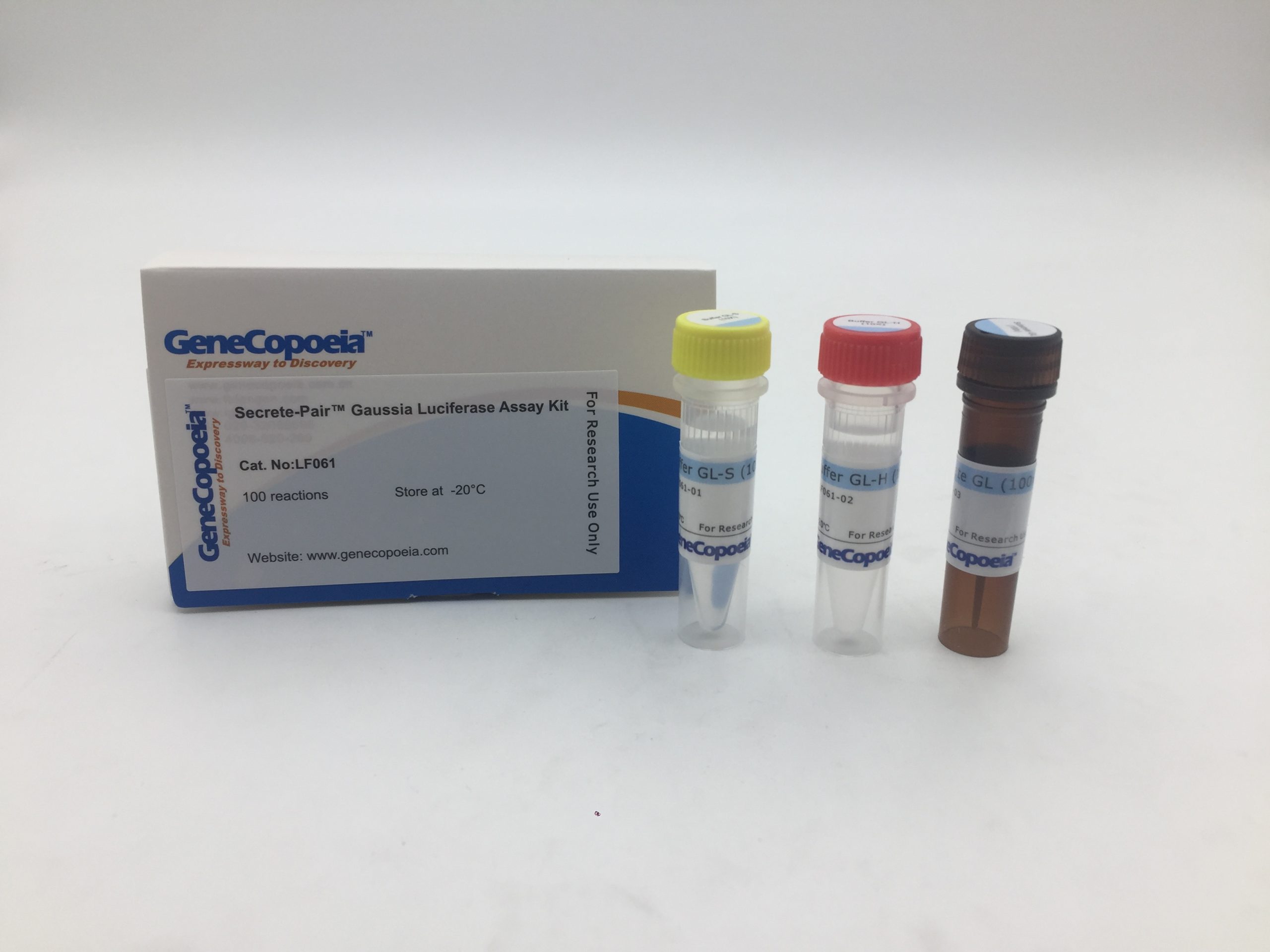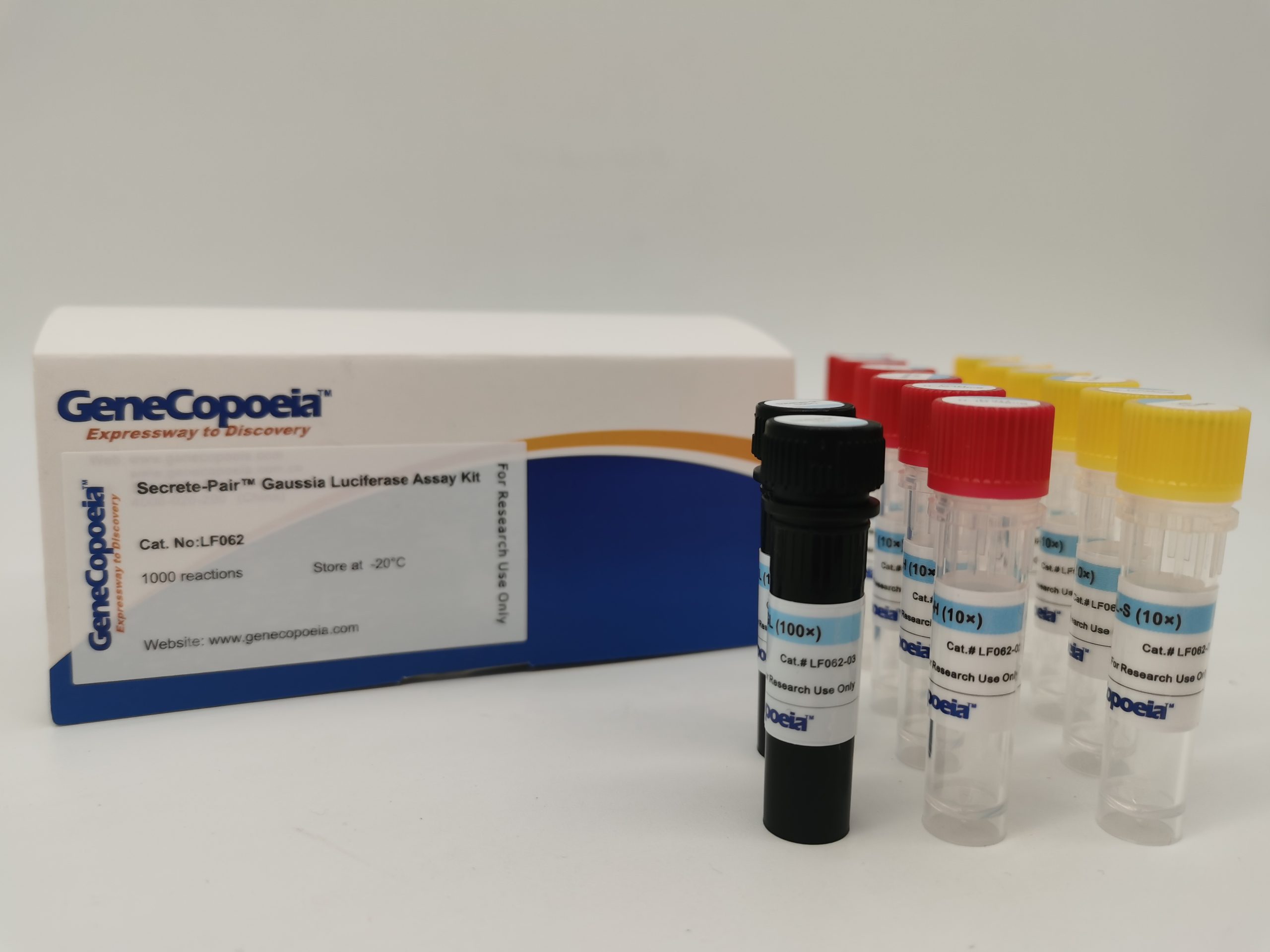Introduction
Secrete-Pair™ Gaussia Luciferase Dual and Single Luminescence Assay Kits
|
GeneCopoeia’s Secrete-Pair™ Dual Luminescence Assay Kit is designed to analyze the activities of Gaussia Luciferase (GLuc) and Secreted Alkaline Phosphatase (SEAP) in a dual-reporter system. Both GLuc and SEAP are secreted reporter proteins, permitting detection without cell lysis. Secrete-Pair measures dual reporter signals and allows transfection normalization. A single GLuc reporter system is also available.
|
Advantages
• Live cell assays. Secreted GLuc and SEAP make cell lysis unnecessary. The same sample can be assayed multiple times for different time points, environmental conditions, etc., reducing sample-to-sample variation. Ideal for high-throughput applications.
• Dual-reporter detection. SEAP allows normalization of GLuc signal for greater accuracy.
• Sensitive and robust system. GLuc is 1,000 times more sensitive than firefly and Renilla luciferases.
• Flexible assay conditions. Two robust buffer conditions are provided for GLuc assays: 1) Buffer for greater stability retains more than 90% of signal within the first 10 minutes, extending the half-life of luminescence to 30 minutes; 2) Buffer for higher sensitivity for detecting low GLuc expression.
• Clone and vector compatibility. Compatible with GeneCopoeia’s GLuc-ON™ promoter reporter clones, miTarget™ miRNA target clones, GLuc-ON™ Transcriptional Response Element (TRE) clones, and cloning vectors.
To Order
Additional related clones
Additional related reagents
Protocol and Data
Protocol Overview
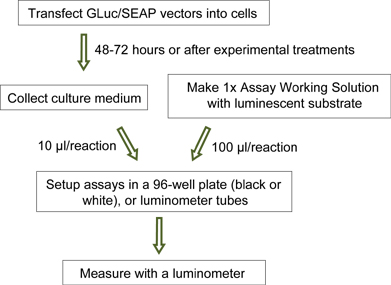
Figure 1. General workflow for the Secrete-Pair™ Dual Luminesence Assay System.
Dual-reporter system
The Secrete-Pair™ Dual Luminescence Assay System is ideally suited for dual-reporter vectors and clones, such as those available for the GLuc-ON™ promoter clones and miTarget™ microRNA target clones. The secondary reporter, secreted Alkaline Phosphatase (SEAP), serves as an internal control. The dual-reporter system enables transfection normalization for accurate cross-sample comparison (Figure 2).
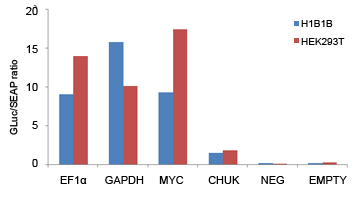 |
|
| Figure 2. Normalized promoter activities in H1B1B and HEK293T cells. Dual-reporter promoter clones or controls were transfected into two cell lines in duplicates. Samples were analyzed 24 hrs (HEK293T) and 48 hrs (H1B1B) after transfection. NEG (containing non-promoter sequence) and EMPTY (no promoter in the vector) are negative controls. |
Two buffer conditions are provided in the kit for GLuc assays depending on the application. Buffer GL-S contains a stabilizer and can be used for stabilized activity by overcoming the quick decay of the GLuc signal. When higher signal intensities are needed, Buffer GL-H is used instead (Figure 3).
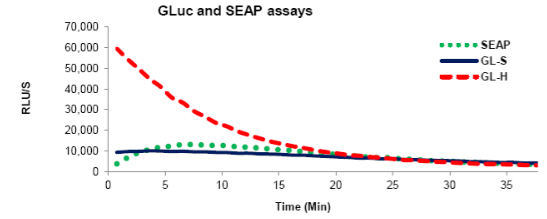
Figure 3. GLuc and SEAP assays. Cell culture medium was collected from cells transfected with wild-type (wt) GLuc- SEAP dual-reporter clone. 10 μl of the medium was used in each assay. At the beginning, the GLuc activity in Buffer GL- H is about 4-6 times higher than that in Buffer GL-S, then quickly decays. The GLuc activity in Buffer GL-S, however, is much more stable.
FAQs
Frequently Asked Questions: Gaussia luciferase Assays
Answer: To visualize Firefly and Renilla luciferase activity, it is necessary to first lyse the cells. On the other hand, GeneCopoeia’s Secrete-Pair™ Dual Luminescence Assay system uses two secreted reporters: Gaussia luciferase (GLuc) and secreted alkaline phosphatase (SEAP). Secreted reporters can be detected in the cell medium without lysing the cells. Therefore, you can assay the same sample multiple times, which is provides greater accuracy and reproducibility than assaying multiple samples in applications such as time course assays.
Answer: “RLU” stands for “Relative Light Unit”. Luminometers do not measure light output, in terms of numbers of photons, directly.
Answer: The Secrete-Pair™ Gaussia luciferase kits are compatible with all known luminometers.
Answer: All Secrete-Pair™ reagents are stable for at least 6 months if stored at -20°C.
Answer: To prevent loss of activity, it is best to avoid repeated freezing and thawing. We recommend pipetting small aliquots into new, clean, sterile tubes and placing those aliquots at -20°C. Once you have thawed one of the aliquots, discard it instead of putting it back in the freezer.
Answer: The Gaussia luciferase substrate, coelenterazine, is also the substrate for Renilla luciferase, so it is compatible with Renilla. However, coelenterazine cannot be used with Firefly (Photinus pyralis) luciferase, which instead uses luciferin as its substrate.
Answer: Unfortunately, the individual components of the Secrete-Pair™ kits cannot be purchased separately at this time.
Answer: Typically, between 12 and 24 hours.
Answer: Buffer GL-S, which provides greater signal stability, is most useful when assaying a relatively large number of samples. Its enhanced signal stability means that there will be little sample-to-sample variation due to signal decay. Buffer GL-H is used when maximal signal intensity is required, but the trade-off is that the signal decays more rapidly under typical laboratory conditions. Buffer GL-H is not appropriate for measuring the activities of large numbers of samples, unless sample injectors are used.

-scaled.jpg)
